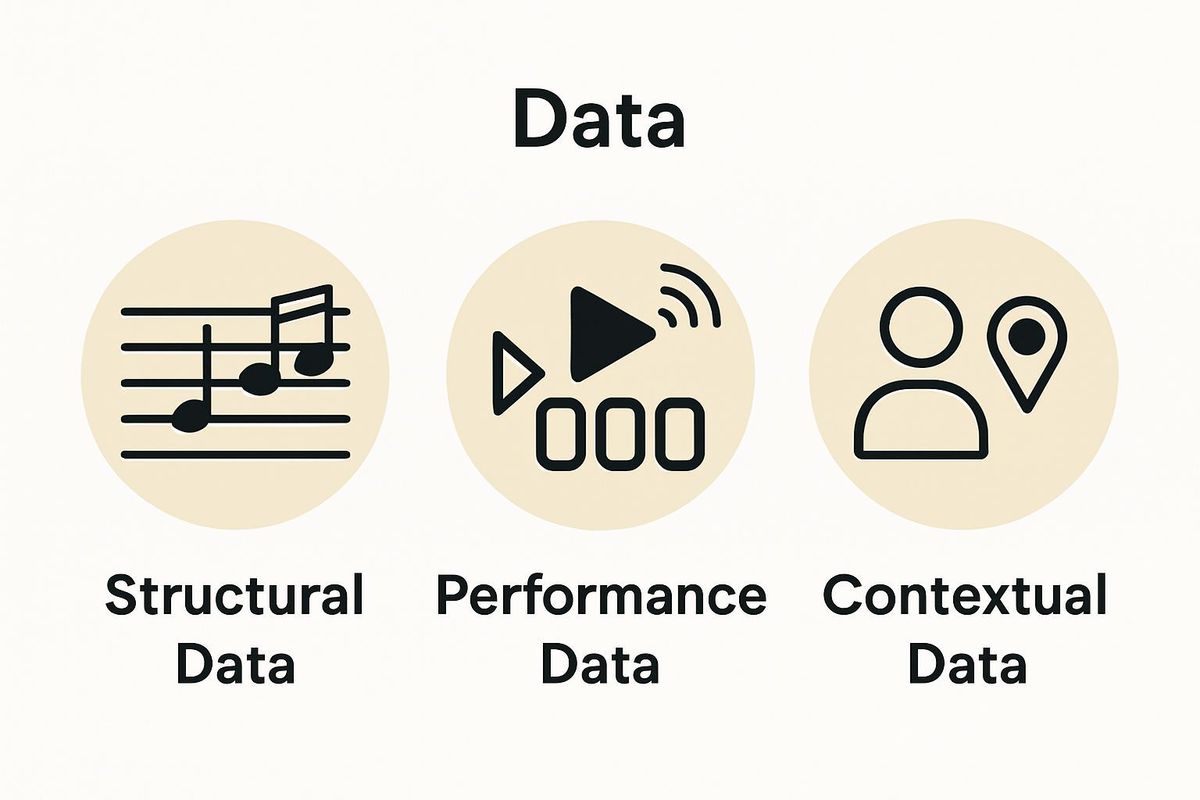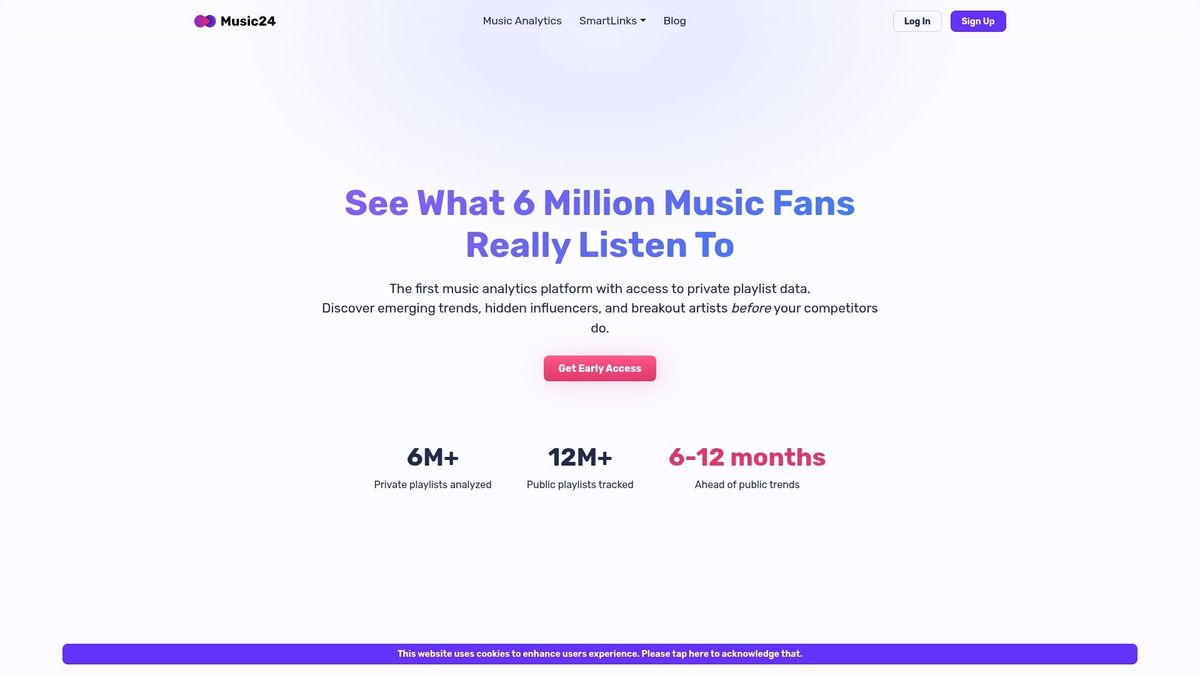Music data goes way beyond just tracking a few streams or downloads. Streaming platforms process billions of listener actions every day, collecting everything from skip rates to the exact second listeners pause a track. Most people think music data is all about numbers and charts, but it is actually reshaping the way new artists are discovered and how hits are predicted before they even go viral.
Table of Contents
- Defining Music Data: Categories And Types
- Analyzing Music Data: Techniques And Tools
- Real-World Applications Of Music Data In The Industry
Quick Summary
| Takeaway | Explanation |
|---|---|
| Music data enhances decision-making | Analyzing music data allows professionals to make informed choices about artist development and marketing efforts. |
| Understanding audience engagement is critical | Tracking metrics like streaming counts and listener demographics helps optimize marketing strategies and reach target audiences effectively. |
| Predictive analytics reshape talent identification | By using complex data analysis, professionals can forecast emerging artists and adapt strategies to industry trends. |
| Resource allocation improves with data insights | Data-driven decisions allow for precise investment in marketing and artist promotion, maximizing potential returns. |
| Advanced tools are essential for analysis | Employing machine learning and visualization techniques enables deeper insights and better understanding of musical ecosystems. |
Defining Music Data: Categories and Types
Music data represents the complex digital footprint that captures the multifaceted nature of musical content, consumption, and interaction. At its core, music data encompasses a wide range of information that goes far beyond simple audio files, transforming how music professionals understand and analyze musical ecosystems.
Fundamental Categories of Music Data
Music data can be broadly categorized into several critical types that provide comprehensive insights into musical creation, distribution, and audience engagement. These categories help industry professionals make informed decisions and understand intricate music consumption patterns.
The following table summarizes the main categories of music data along with their core characteristics and examples mentioned in the article.
| Category | Description | Example Data Types |
|---|---|---|
| Structural Data | Technical information about a musical composition and its elements | Tempo, key signature, time signature, chord progressions |
| Performance and Consumption Data | Tracks how music is experienced and shared across platforms | Streaming counts, skip rates, playlist inclusions, device use |
| Contextual and Metadata | Provides cultural, narrative, and historical context of musical works | Artist biography, genre, regional associations, collaborations |

Structural Data
Structural data provides fundamental technical information about musical compositions. This includes technical attributes like tempo, key signature, time signature, chord progressions, and instrumentation. Such data helps music analysts understand the technical composition of tracks and how different musical elements interact. Learn more about the role of metadata in music analytics.
Performance and Consumption Data
Performance data tracks how music is experienced and shared across different platforms. This category includes:
- Streaming counts
- Playlist inclusions
- Skip rates
- Listener engagement times
- Geographic listening patterns
- Device and platform distribution
Contextual and Metadata
Contextual data provides deeper insights into the narrative and cultural significance of musical works. This includes:
- Artist biographical information
- Genre classifications
- Cultural and regional associations
- Collaborative networks
- Historical performance contexts
By understanding these diverse types of music data, professionals can unlock powerful insights into musical trends, audience preferences, and emerging artistic innovations. The ability to analyze and interpret these complex datasets transforms how the music industry identifies talent, develops marketing strategies, and connects artists with their audiences.
The Role of Music Data in Decision Making
Music data serves as a strategic compass for music industry professionals, enabling precise, data driven decision making across multiple domains. By transforming raw information into actionable intelligence, these insights guide critical choices in artist development, marketing strategies, and talent identification.
Strategic Resource Allocation
Decision makers leverage music data to optimize resource allocation with unprecedented precision. Explore our comprehensive guide to music data interpretation to understand how these analytics transform traditional approaches. Industry professionals can now pinpoint exactly where to invest time, marketing budgets, and creative resources by analyzing comprehensive data streams.
Key strategic considerations include:
- Identifying emerging artist potential
- Predicting audience engagement trends
- Evaluating marketing campaign effectiveness
- Understanding cross genre listener behaviors
- Mapping geographical music consumption patterns
Predictive Analytics and Artist Development
Modern music data analytics go beyond retrospective analysis, offering predictive capabilities that reshape artist development strategies. By examining complex listener behaviors, streaming patterns, and audience interactions, professionals can:
- Forecast potential breakthrough artists
- Recommend targeted collaboration opportunities
- Design personalized audience engagement strategies
- Anticipate genre evolution and emerging musical trends
Risk Mitigation and Investment Decisions
Data driven insights dramatically reduce investment risks in the music industry. Record labels, talent agencies, and streaming platforms use sophisticated music data analysis to make informed decisions about artist signings, tour planning, and content promotion. These analytics provide a quantitative foundation for what was previously considered intuitive decision making, transforming music industry strategy from art to science.
This table provides a concise comparison of how music data is used across key decision-making areas within the industry, based on the article content.
| Decision Area | How Music Data is Used | Example Insights |
|---|---|---|
| Resource Allocation | Optimize investments in marketing, talent, and strategy | Pinpointing where to spend marketing budgets |
| Predictive Analytics | Forecast trends and anticipate emerging artists | Predicting audience engagement, genre evolution |
| Risk Mitigation | Reduce uncertainty in artist signings and promotional efforts | Data-driven artist signings, tour planning, content push |

By embracing comprehensive music data analysis, industry professionals can navigate an increasingly complex musical landscape with confidence, turning raw information into strategic advantage.
Analyzing Music Data: Techniques and Tools
Analyzing music data requires sophisticated techniques and specialized tools that transform raw musical information into actionable insights. These advanced methodologies enable music industry professionals to extract meaningful patterns and understand complex musical ecosystems with unprecedented depth and precision.
Signal Processing and Feature Extraction
Signal processing represents the foundational technique for music data analysis. Discover the comprehensive benefits of music analytics to comprehend how these technical approaches revolutionize musical understanding. These techniques involve extracting critical technical attributes from audio signals, including:
- Frequency spectrum analysis
- Rhythmic pattern identification
- Harmonic complexity measurement
- Timbre and texture characterization
- Audio fingerprinting and recognition
Machine Learning and Predictive Models
Advanced machine learning algorithms transform music data analysis by enabling complex pattern recognition and predictive modeling. Artificial intelligence techniques allow professionals to:
- Classify musical genres automatically
- Predict listener preferences
- Generate recommendation systems
- Understand emotional characteristics of musical compositions
- Detect emerging musical trends
Advanced Visualization and Interpretation Tools
The most powerful music data analysis strategies combine technical processing with sophisticated visualization tools. These platforms translate complex datasets into intuitive visual representations, allowing music professionals to:
- Map listener behavior across geographic regions
- Track artist performance metrics
- Understand audience engagement patterns
- Visualize musical evolution and genre intersections
By leveraging these sophisticated techniques and tools, music industry professionals can convert intricate data streams into strategic insights, driving innovation and understanding in an increasingly complex musical landscape.
Real-World Applications of Music Data in the Industry
Music data has transformed from a supplementary resource to a critical strategic tool across multiple domains of the music industry. By providing granular insights and predictive capabilities, these data streams enable professionals to make informed decisions with unprecedented precision and strategic depth.
Artist Discovery and Development
Learn more about the music analytics workflow for success to understand how emerging technologies are revolutionizing talent identification. Music data enables record labels and talent agencies to:
- Identify promising emerging artists
- Analyze audience engagement metrics
- Predict potential commercial success
- Recommend targeted marketing strategies
- Evaluate potential collaboration opportunities
Strategic Marketing and Promotion
Data driven marketing strategies have become the cornerstone of modern music promotion. By analyzing comprehensive listener data, music industry professionals can:
- Create highly targeted audience segments
- Design personalized promotional campaigns
- Optimize digital advertising spend
- Understand cross genre listener behaviors
- Track real time audience response to releases
Revenue Optimization and Business Intelligence
Music data provides critical insights that directly impact financial strategies and revenue generation. Advanced analytics enable professionals to:
- Forecast streaming revenue potential
- Identify lucrative touring and performance opportunities
- Understand global market expansion possibilities
- Evaluate merchandise and brand partnership potential
- Develop data driven pricing strategies
By leveraging sophisticated music data analysis, industry professionals transform raw information into strategic assets, driving innovation and creating more intelligent, responsive musical ecosystems.
Ready to Turn Music Data Into Your Competitive Edge?
If you read about the complexity of music data and the power of analyzing listener behavior before it shows up in public charts, you already know how vital it is to move beyond surface-level streaming stats. The challenge is clear: relying only on public data means you’re likely missing authentic discovery patterns, hidden trends, and rising artists who could break through. Music24 empowers you to go deeper by tapping into private playlist data, unlocking true insights from real tastemakers and music fans. You gain access to early signals for emerging talent, influential curator activity, and micro-trends that other platforms simply cannot see. Curious about how advanced analytics and private playlists can give you that first-mover advantage?

Experience the difference for yourself. Visit Music24 now to see how our unique platform transforms raw music data into actionable insights for artist discovery, marketing, and strategic decision-making. Don’t let the next big musical breakthrough slip past you while relying on outdated public metrics. Take your music strategy to the next level today by exploring our specialized predictive analytics and artist discovery solutions. The future of A&R and music marketing starts here.
Frequently Asked Questions
What are the main categories of music data?
Music data can be broadly categorized into structural data, performance and consumption data, and contextual metadata. Each category provides unique insights into musical creation, distribution, and audience engagement.
How is music data used in decision making within the music industry?
Music data serves as a strategic resource for talent identification, artist development, and marketing strategy formulation. It helps professionals make data-driven decisions that optimize resource allocation and predict audience engagement trends.
What techniques are used to analyze music data?
Common techniques for analyzing music data include signal processing, feature extraction, and machine learning algorithms. These methods help identify patterns, predict listener preferences, and provide actionable insights.
How can music data drive revenue optimization for artists and labels?
Music data enables professionals to forecast streaming revenue, identify lucrative touring opportunities, and develop pricing strategies based on audience insights. This data-driven approach enhances financial strategies and supports business growth.


